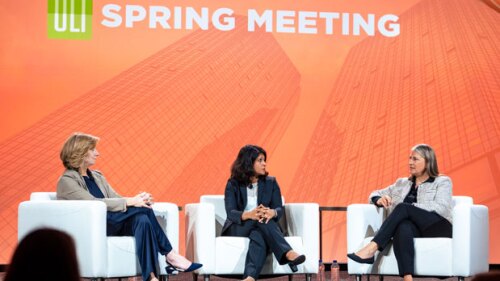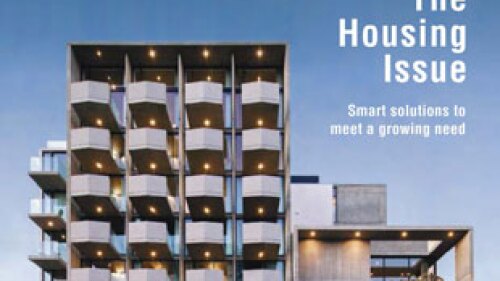| Duke Reiter |
| Mayor Phil Gordon |
Partnerships, mobility, creativity, and clear vision of the elements necessary for a high quality of life will result in the successful cities of the future say Phoenix, Arizona, Mayor Phil Gordon, Salt Lake City, Utah, Mayor Ralph Becker, former Pittsburgh, Pennsylvania, Mayor Thomas Murphy and Story Bellows, director Mayors’ Institute on City Design. The Mayors and experts spoke at a ULI Spring Council Forum panel titled “Challenges and Opportunities Facing Cities Today” moderated by Duke Reiter, special advisor to the president of Arizona State University (ASU). The standing-room only session included a lively discussion on the specific actions and long-term philosophies that guided the emergence of Phoenix and Salt Lake City as high-quality urban areas and the rebirth of other successful cities such as Pittsburgh.
Opening the session with a perspective on why cities are vital now, Reiter described modern urban areas as the “fulfillment of Richard Florida’s concept of the creative class” saying, “Jobs will go where people want to live.” Reiter pointed out that 90 percent of the top 50 research universities are in major cities and 70 percent of U.S. gross domestic product is represented by major cities, concluding that “our attendance to their [cities] issues is on top of the bar.”
Outlining his philosophy on what makes a successful city, Phoenix Mayor Phil Gordon acknowledged that decision-makers “need a new definition for quality of life” and must recognize that “the city’s core is its heartbeat.” He challenged cities to “take partnership to the highest levels. Go to the opportunities, don’t just sit. Don’t let the naysayers win.” He said quality of life “used to be salary, the size of a house and the number of cars a person owns.” Today, Gordon said, “We realize quality of life is about sustainability. . . about environment and attracting and expanding companies. It’s about quality of education—making sure students are competitive when they graduate and about quality retraining opportunities.”
Emphasizing the need for and importance of partnerships in creating cities of the future, Gordon pointed to the public-private partnerships that resulted in the development of the ASU downtown campus and the downtown Phoenix Bioscience Center. The Bioscience Center houses the International Genomics Consortium and the Translational Genomics Research Institute (T-Gen), a National Institutes of Health lab, Catholic Healthcare West and the Molecular Profiling Institute, and, in the near future, the University of Arizona Cancer Center.
| Mayor Ralph Becker |
| Former Mayor Thomas Murphy |
The ASU partnership resulted in an immediate economic return on the city’s investment in the form of jobs, sales tax and new business expanding or starting to supply ASU. Recognizing that upgrades and maintenance of infrastructure are also important to quality of life, Gordon said cities must continue to upgrade parks, provide public safety, ensure water quality, maintain streets and promote innovation and reduce costs through the use of solar, graywater and technology.
Salt Lake City Mayor Ralph Becker described mobility—transit, trails and bikeways—as the transformative elements of Salt Lake City. Saying that “this is an exciting time” and that cities are being “driven by changes in energy, resources, climate, and demographics and changes in needs about how people interact,” he identified revenue sourcing (cities need more tools to maintain core services), mobility choices (infrastructure is expensive but critical to long-term sustainability), developing efficiencies (by taking a regional approach to providing services), civic engagement of disenfranchised residents, and adapting to climate change as important for cities of the future to address.
Salt Lake City’s biggest challenge, according to Becker, is its shrinking revenue base (budgets were cut by 20 percent) combined with accomplishing an ambitious agenda for change. He said the ability of municipal leaders to adapt quickly and sense changes in opportunities or market conditions is vital to their success. Becker’s vision for Salt Lake City is to broadly achieve a livable, sustainable community. This means comprehensively and holistically looking at all the actions that are necessary to plan for and proactively pursue the future that Salt Lake City wants. The mayor said that some of the specific steps Salt Lake City may take include a complete zoning ordinance rewrite, examining how the city deals with recycling and reuse, supporting Salt Lake City’s and Utah’s rich tradition of urban agriculture, and building on the city’s rich tradition of self-sufficiency.
In describing the ordinance rewrite, Becker said, “Most of the ordinance rewrite is to find changes to just get “out of the way” of pedestrian and transit oriented development and provide a framework to achieve the kind of livable and sustainable community Salt Lake City wants without government being an obstacle. People want an urban lifestyle. We in government can help with important investments, have a clear vision and bring people together to achieve what we want. Ultimately, it also needs to be government getting out of the way sometimes.”
Becker recognizes that Salt Lake City is most known for transforming its transportation system and enhancing mobility in the community. He credited the Utah Transit Authority with building light rail despite voter opposition. As a result of the overwhelming success of light rail (the first 15 miles [24 km] built were on time and on budget and ridership is double projections), many referendums to support expansion of the system have passed. Becker said that by 2015, an additional 20 miles [32 km] of light rail will be completed as well as a commuter rail line. Next year, the city will also be starting redevelopment of its street car system with a Transportation Investment Generating Economic Recovery (TIGER) grant. Other ways that Salt Lake City is transforming mobility options include a ten-fold increase in funding for bicycle facilities and new pedestrian and transit-oriented development ordinances.
Former Pittsburgh Mayor and Senior Resident Fellow of ULI Thomas Murphy described the successful city of the future as safe, clean, and efficient. He pointed to a successful K–20 education system, an entrepreneurial public-private business climate, available financing, and world-class anchor institutions as key elements of a high quality of life. Recounting Pittsburgh’s revitalization, Murphy said the city lost 200,000 people and 180,000 jobs between 1970 and 1990. As a result of making choices that changed the status quo and reflected the city’s priorities, Pittsburgh regained residents and employment and is now recognized as one of the most livable cities in the United States. He emphasized that Pittsburgh achieved its success through a clear vision, partnerships, and making civic investments in bad budget years as well as good, pointing out that “Investment in the future entails risk . . . and if there is a place that is very risk adverse it is politics. . . . It’s about being entrepreneurial on both sides of the table and being as wiling as the private sector to take risk.”
| Story K. Bellows |
Murphy used Pittsburgh’s decision to buy and bring to the table thousands of acres of abandoned steel mills as an example of the city’s entrepreneurial approach to creating partnerships that helped it revitalize. He said these types of actions create an environment that encourages private investment. “If I’m a developer, I want to know the mayor is investing in the future and not being the hamster on the whee,” added Murphy.
Story K. Bellows, the director of the Mayor’s Institute on City Design, spoke about the need for more flexible, innovative tools for financing visionary investments, stating that cities are still challenged by process and implementation of getting deals done. She focused on public space, saying it is critical to successful cities in the 21st century. Bellows referred to a Knight Foundation/Gallup poll which found that openness, social offerings and aesthetics are the key things that connect people to their cities. She said that these types of public investments drive private investment and that these investments can take place on a large or small scale.








